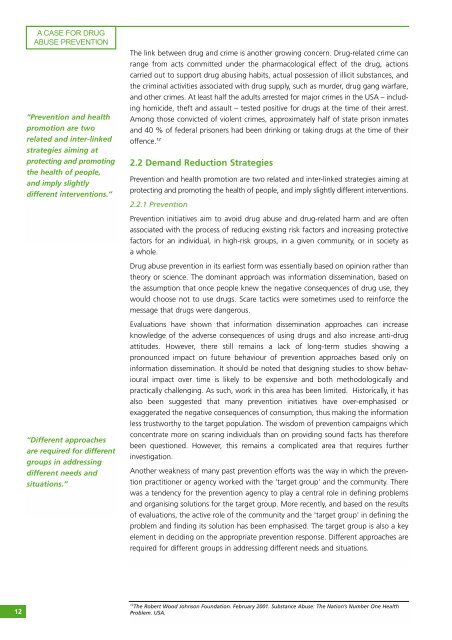PDF (Lessons learned in drug abuse prevention: a global review)
PDF (Lessons learned in drug abuse prevention: a global review)
PDF (Lessons learned in drug abuse prevention: a global review)
You also want an ePaper? Increase the reach of your titles
YUMPU automatically turns print PDFs into web optimized ePapers that Google loves.
A CASE FOR DRUG<br />
ABUSE PREVENTION<br />
“Prevention and health<br />
promotion are two<br />
related and <strong>in</strong>ter-l<strong>in</strong>ked<br />
strategies aim<strong>in</strong>g at<br />
protect<strong>in</strong>g and promot<strong>in</strong>g<br />
the health of people,<br />
and imply slightly<br />
different <strong>in</strong>terventions.”<br />
“Different approaches<br />
are required for different<br />
groups <strong>in</strong> address<strong>in</strong>g<br />
different needs and<br />
situations.”<br />
The l<strong>in</strong>k between <strong>drug</strong> and crime is another grow<strong>in</strong>g concern. Drug-related crime can<br />
range from acts committed under the pharmacological effect of the <strong>drug</strong>, actions<br />
carried out to support <strong>drug</strong> abus<strong>in</strong>g habits, actual possession of illicit substances, and<br />
the crim<strong>in</strong>al activities associated with <strong>drug</strong> supply, such as murder, <strong>drug</strong> gang warfare,<br />
and other crimes. At least half the adults arrested for major crimes <strong>in</strong> the USA – <strong>in</strong>clud<strong>in</strong>g<br />
homicide, theft and assault – tested positive for <strong>drug</strong>s at the time of their arrest.<br />
Among those convicted of violent crimes, approximately half of state prison <strong>in</strong>mates<br />
and 40 % of federal prisoners had been dr<strong>in</strong>k<strong>in</strong>g or tak<strong>in</strong>g <strong>drug</strong>s at the time of their<br />
offence. 12<br />
2.2 Demand Reduction Strategies<br />
Prevention and health promotion are two related and <strong>in</strong>ter-l<strong>in</strong>ked strategies aim<strong>in</strong>g at<br />
protect<strong>in</strong>g and promot<strong>in</strong>g the health of people, and imply slightly different <strong>in</strong>terventions.<br />
2.2.1 Prevention<br />
Prevention <strong>in</strong>itiatives aim to avoid <strong>drug</strong> <strong>abuse</strong> and <strong>drug</strong>-related harm and are often<br />
associated with the process of reduc<strong>in</strong>g exist<strong>in</strong>g risk factors and <strong>in</strong>creas<strong>in</strong>g protective<br />
factors for an <strong>in</strong>dividual, <strong>in</strong> high-risk groups, <strong>in</strong> a given community, or <strong>in</strong> society as<br />
a whole.<br />
Drug <strong>abuse</strong> <strong>prevention</strong> <strong>in</strong> its earliest form was essentially based on op<strong>in</strong>ion rather than<br />
theory or science. The dom<strong>in</strong>ant approach was <strong>in</strong>formation dissem<strong>in</strong>ation, based on<br />
the assumption that once people knew the negative consequences of <strong>drug</strong> use, they<br />
would choose not to use <strong>drug</strong>s. Scare tactics were sometimes used to re<strong>in</strong>force the<br />
message that <strong>drug</strong>s were dangerous.<br />
Evaluations have shown that <strong>in</strong>formation dissem<strong>in</strong>ation approaches can <strong>in</strong>crease<br />
knowledge of the adverse consequences of us<strong>in</strong>g <strong>drug</strong>s and also <strong>in</strong>crease anti-<strong>drug</strong><br />
attitudes. However, there still rema<strong>in</strong>s a lack of long-term studies show<strong>in</strong>g a<br />
pronounced impact on future behaviour of <strong>prevention</strong> approaches based only on<br />
<strong>in</strong>formation dissem<strong>in</strong>ation. It should be noted that design<strong>in</strong>g studies to show behavioural<br />
impact over time is likely to be expensive and both methodologically and<br />
practically challeng<strong>in</strong>g. As such, work <strong>in</strong> this area has been limited. Historically, it has<br />
also been suggested that many <strong>prevention</strong> <strong>in</strong>itiatives have over-emphasised or<br />
exaggerated the negative consequences of consumption, thus mak<strong>in</strong>g the <strong>in</strong>formation<br />
less trustworthy to the target population. The wisdom of <strong>prevention</strong> campaigns which<br />
concentrate more on scar<strong>in</strong>g <strong>in</strong>dividuals than on provid<strong>in</strong>g sound facts has therefore<br />
been questioned. However, this rema<strong>in</strong>s a complicated area that requires further<br />
<strong>in</strong>vestigation.<br />
Another weakness of many past <strong>prevention</strong> efforts was the way <strong>in</strong> which the <strong>prevention</strong><br />
practitioner or agency worked with the 'target group' and the community. There<br />
was a tendency for the <strong>prevention</strong> agency to play a central role <strong>in</strong> def<strong>in</strong><strong>in</strong>g problems<br />
and organis<strong>in</strong>g solutions for the target group. More recently, and based on the results<br />
of evaluations, the active role of the community and the 'target group' <strong>in</strong> def<strong>in</strong><strong>in</strong>g the<br />
problem and f<strong>in</strong>d<strong>in</strong>g its solution has been emphasised. The target group is also a key<br />
element <strong>in</strong> decid<strong>in</strong>g on the appropriate <strong>prevention</strong> response. Different approaches are<br />
required for different groups <strong>in</strong> address<strong>in</strong>g different needs and situations.<br />
12<br />
12 The Robert Wood Johnson Foundation. February 2001. Substance Abuse: The Nation’s Number One Health<br />
Problem. USA.
















